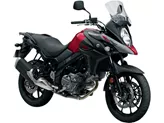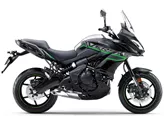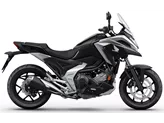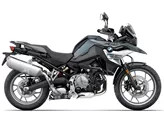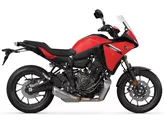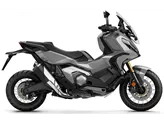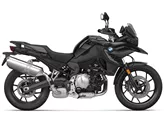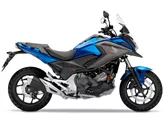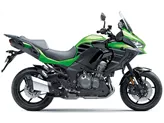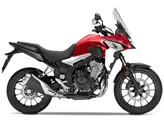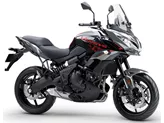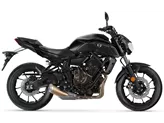Honda NC750X 2016 vs. Kawasaki Versys 650 2016

Honda NC750X 2016

Kawasaki Versys 650 2016
Overview - Honda NC750X 2016 vs Kawasaki Versys 650 2016
The Honda NC750X 2016 and the Kawasaki Versys 650 2016 are both popular enduro motorcycles that offer a range of features and capabilities. While they have some similarities in terms of engine type, transmission, and dimensions, there are also notable differences that set them apart.
Starting with the engine and drive train, both motorcycles have an in-line engine configuration with two cylinders. However, the Honda NC750X has a slightly smaller bore of 77 mm compared to the Kawasaki Versys 650's 83 mm. The stroke of the Honda NC750X is 80 mm, while the Kawasaki Versys 650 has a stroke of 60 mm. In terms of power, the Kawasaki Versys 650 has a slight advantage with 69 HP compared to the Honda NC750X's 55 HP. However, the Honda NC750X has a higher torque of 68 Nm compared to the Kawasaki Versys 650's 64 Nm. Both motorcycles have an electric starter and chain transmission.

Honda NC750X 2016
Moving on to the chassis, both the Honda NC750X and the Kawasaki Versys 650 have a steel frame. In terms of dimensions and weights, the Honda NC750X has a slightly longer wheelbase of 1540 mm compared to the Kawasaki Versys 650's 1415 mm. The seat height of the Honda NC750X is 830 mm, while the Kawasaki Versys 650 has a slightly higher seat height of 840 mm. The kerb weight of the Honda NC750X with ABS is 219 kg, while the Kawasaki Versys 650 weighs slightly less at 216 kg. The fuel tank capacity of the Honda NC750X is 14.1 liters, while the Kawasaki Versys 650 has a larger tank capacity of 21 liters.
Now let's discuss the strengths and weaknesses of each motorcycle. The Honda NC750X is known for being very manageable and affordable, making it a great option for riders of all experience levels. It also has low fuel consumption, which is a major advantage for those looking for a cost-effective ride. The DCT dual-clutch transmission and adjustable driving modes provide added convenience and versatility. Additionally, the Honda NC750X has good brakes, ensuring reliable stopping power.
On the other hand, the Kawasaki Versys 650 has adjustable brake and clutch levers, allowing riders to customize their riding experience. It also has a wide range of use, making it suitable for various terrains and riding styles. The 21-liter fuel tank capacity is a significant advantage for long-distance rides, as it reduces the need for frequent refueling. Lastly, the Kawasaki Versys 650 has a sporty look that appeals to riders who prioritize aesthetics.

Kawasaki Versys 650 2016
However, the Honda NC750X does have some weaknesses. The engine is considered weak compared to its competitors, and it has an early onset of the rev limiter, limiting its performance potential. On the other hand, the Kawasaki Versys 650 has narrow handlebars, which may not suit riders who prefer a wider grip. It is also somewhat sluggish in bends, potentially affecting its maneuverability. Additionally, the high seat height of the Kawasaki Versys 650 may be a disadvantage for shorter riders.
In conclusion, both the Honda NC750X 2016 and the Kawasaki Versys 650 2016 have their own strengths and weaknesses. The Honda NC750X is praised for its manageability, affordability, and low fuel consumption, while the Kawasaki Versys 650 offers adjustable levers, a wide range of use, and a larger fuel tank capacity. Ultimately, the choice between these two motorcycles will depend on the rider's preferences and priorities.
Technical Specifications Honda NC750X 2016 compared to Kawasaki Versys 650 2016
Pros and Cons in comparison
Pros and Cons in comparison
Honda NC750X 2016

With its DCT (Dual Clutch Transmission), the NC750X is the most coherent model in the NC range. With its windshield, long suspension travel and the resulting increase in comfort, it is also suitable for longer distances and even travelling. After all, why shouldn't beginners also be able to enjoy comfortable yet uncomplicated travel? Above all, the comparatively low centre of gravity takes away the fear of the visually much larger and more bulky NC750X, even for inexperienced riders. The engine is not too sporty, but the DCT, which changes gears extremely precisely and easily at the touch of a button or even fully automatically, quickly makes you forget that. The helmet compartment under the dummy tank is particularly ingenious.
Kawasaki Versys 650 2016

When it was first introduced, the Versys 650 was a refreshing, modern concept that combined lots of fun with a lively in-line two-cylinder engine, high everyday utility and a wide range of uses. In the meantime, it has a few years under its belt and, after the visual update, which is very successful, it also deserves a technical overhaul. While the tank should not shrink, a lower seat height would be desirable.
Price Comparison Avarage Market Price Honda NC750X vs Kawasaki Versys 650
There are a few key differences between a Honda NC750X 2016 and a Kawasaki Versys 650 2016. It takes less time to sell a Honda NC750X with 77 days compared to 101 days for a Kawasaki Versys 650. Since model year 2014 1000PS.de editors have written 23 reviews for the Honda NC750X and 39 reviews for the Kawasaki Versys 650 since model year 2007. The first review for the Honda NC750X was published on 03/11/2013 and now has more than 8,800 views. This compares to more than 3,900 views for the first review on Kawasaki Versys 650 published on 25/07/2006.


